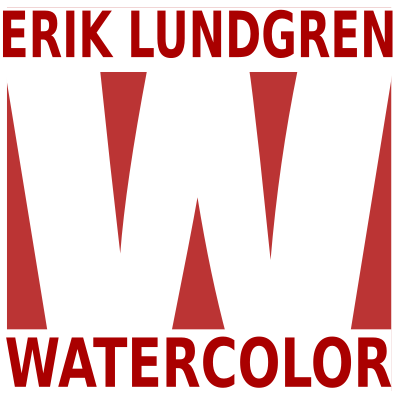The Hofterup Dolmen

Hofterupsdösen is a dolmen, a tomb from the Neolithic era. It is located just east of Hofterup Church in Kävlinge Municipality, not far from where I live. It may seem like a tricky subject for a watercolor painting, but it actually works well as an exercise, as it involves several different watercolor techniques.
You can use any colors you want for this exercise. I used two browns (burnt and raw sienna), a blue (phthalo), and a warm yellow (I used nickel dioxin yellow, which is no longer produced, but any warm yellow will do).

Step 1

Start by painting the sky, painting around the stones and down to the horizon. Feel free to add some gray (blue + burnt sienna) at the bottom of the sky, representing shadows under white clouds. To create clouds, you can lift off some blue color here and there with a paper towel or something similar. Let the sky dry completely before starting the next step.
Step 2

Following the principle of “back to front,” first paint the dark green distant trees. Use a color mixed from blue and yellow, with a bit of brown. Create a straight bottom edge and an uneven, tree-like top. Let it dry, then paint the light green field. Make it slightly lighter and cooler (bluer) near the trees, and warmer with a more yellowish and fuller color toward the foreground. This helps indicate depth in the painting. Don’t forget there’s tall grass in front of the field, which you should show by painting grass blades when you do the green behind the grass. Finish the green field at the bottom by leaving out several grass blades, painting “jaggedly” so that the unpainted paper resembles white grass blades.
Next, with a yellow-brown color (raw sienna or yellow ochre), paint the grass in the foreground. This should be painted with hundreds of thin, slightly slanted strokes. The white spaces between the yellow strokes are important. Try to make these as thin as possible. I don’t mean you should paint each blade of grass individually, as that would take forever. Instead, let the brush move up and down in quick strokes, creating a pattern of white, unpainted streaks between the brushstrokes.
Step 3

Paint some yellow-green spots on the stones to represent the lichen and algae growing here and there. Feel free to use a dry brush for these spots to make them look more natural. Then paint some green grass. The green grass, unlike the yellow underpainting, shouldn’t cover the entire surface. Instead, paint it in patches, leaving unpainted areas between more solid green sections. It’s a good idea to use different shades of green that blend on the paper, as this gives a more lively result.
Step 4

Paint blue shadows on the stones. Cover the stones with the blue color but leave the sunlit parts unpainted. The blue shadow color can be painted flat, but it looks better with some wet-on-wet technique to vary the intensity. Use a dark green color to paint dark shadows in the grass. Don’t forget to make the shadow “straw-like” at the top and bottom to make it look like grass.
Step 5

The final step is to give the stones shape. Do this with a neutral, fairly dark color applied over the shaded part of each stone. Let the sunlit part of each stone remain unpainted. Wet-on-wet is a good method for painting these shadows. First, wet a stone and then apply the neutral color where you want it to be dark. Once one stone is done, let it dry before moving on to the next. After all the stones are painted, you can create cracks and other imperfections with extra dark color. You can also use dry brush to achieve rough and textured effects.















Hello Eric. I recently came across your work on youtube and then found your website and very informative blog. I admire your style and result. Thank you for sharing your advice, opinions and instructions. I am a retired optometrist in Atlanta, Georgia, USA and have taken up watercolor painting as a hobby. I was wondering in the painting of the fountain (or really any of your more detailed works), do you draw it directly on the paper or do you work the details out on drawing paper and then trace it? I suspect if I tried to draw such a topic directly on the watercolor paper, I would end up erasing so much as I went along that the paper would be ruined!
When I prepare such large and complicated paintings as you describe, I usually trace the main lines to ensure the perspective and proportions make sense. If needed, I can draw additional details on the watercolor paper. It’s easy when the main lines are already in place, but I often leave the finer details for the actual painting. Erasers are the devil’s invention when it comes to watercolor paper—I never use them.
Thank you, Eric. Ah, to be eraser-free – what a lofty goal.